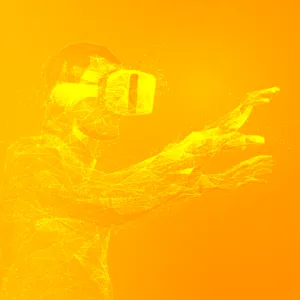Fairly new technologies like Virtual Reality (VR) and Extended Reality (XR) started to often come up in corporate trainings. As we look to the future of digital experiences, two essential components stand out. While they’re intertwined, each has its own impressive list of benefits. Our customers’ stories are told through immersive VR and XR experiences, each born from the combination of their aspirations and our expertise. From identifying the biggest advantages to exploring practical applications, we’ll break down what sets these technologies apart.
Virtual Reality (VR)
What is VR?
Virtual Reality (VR) immerses users in a completely digital environment, cutting off the physical world. By wearing a VR headset, users can explore and interact with a computer-generated 3D world that simulates real-life or fantastical settings. You’ll be fully enveloped in the virtual world, courtesy of rich visuals and surround sound that conjures a true sense of presence.
Applications of VR in Business Training
- Training and Education: VR is extensively used in training simulations for healthcare, aviation, manufacturing, and many other industries. Imagine a space where learners can refine their skills without the pressure of real-world consequences, which is exactly what this environment provides.
- Simulated Training Environments: VR allows your business to create realistic training scenarios for your employees. For example, a healthcare company can simulate surgical procedures, allowing trainees to practice in a risk-free environment.
- Onboarding Programs: Your new hires can be onboarded through virtual office tours and role-playing scenarios that help them understand company processes and culture before they start their jobs.
- Skill Development: Your employees can improve their skills through interactive VR modules that provide hands-on experience without the associated risks or costs.
- Virtual Tours: From real estate to tourism, VR enables users to take virtual tours of properties, museums, and landmarks from anywhere in the world.
Advantages of VR in Business Training
- Immersive Learning: It improves retention and understanding by immersing your team in realistic scenarios.
- Budget-Friendly: VR reduces the need for physical training materials and environments.
- Optimized Engagement: There’s no looking away when this comes on the scene. It’s engaging, entertaining, and pitch-perfect for both learning and leisure.

Extended Reality (XR)
What is XR?
Think of the term Extended Reality (XR) as encompassing Virtual Reality (VR), Augmented Reality (AR), and Mixed Reality (MR). It’s a unified umbrella term that brings them all under one roof. It creates an environment where the haptic and the digital merge, where new ways for humans and machines to interact, learn, and evolve together are born. That’s XR in a nutshell.
Applications of XR in Business Training
- Healthcare: XR technologies are often used for surgical simulations, patient treatment plans, and mental health therapies.
- Manufacturing and Maintenance: It assists in complex assembly processes, remote maintenance, and training with real-time data overlays.
- Interactive Learning Modules: XR technologies can create interactive learning experiences that blend real-world scenarios with digital overlays, enhancing engagement and comprehension.
- Remote Collaboration and Training: XR allows for remote training sessions where your employees or trainees and trainers can interact with each other and with virtual elements, making it ideal for global teams.
- Real-Time Data Visualization: Especially in industries like manufacturing and logistics, XR can overlay real-time data onto physical environments, helping employees understand complex systems and processes better.
Advantages of XR in Business Training
- Versatility: Think beyond the limits of VR and AR. This technology brings your team a versatile platform that satisfies diverse industry needs.
- No hypothetical scenarios: We’re talking about practical application that makes a concrete impact. Picture this: Walking down a street, and the digital world comes alive to help you find your way or fix a broken appliance. This tech brings that kind of helpful tech to everyday life.
- Scalability: This technology can be adapted for your team to use or scaled up for enterprise-level applications.

VR vs. XR: Which Is Right for Your Business?
The choice between VR and XR should be guided by your specific training objectives whether it’s refined technique or reactive decision-making, VR steps in to recreate high-stakes situations, allowing your team to develop their skills without real-world repercussions.
Imagine injecting a digital spark into mundane tasks. That’s what XR can do, giving you the freedom to imagine and develop immersive experiences that rewrite the rules.
If you require a fully immersive environment for training or entertainment, VR might be the ideal choice. Looking for a tech that blends the physical and digital? XR is your answer. With it, you can forge innovative connections and push the boundaries of what’s possible.
Examples from RoT Studio:
- RoT STUDIO License: A user-friendly platform for creating custom VR and XR training modules.
- VR Trainings Catalogue: Offers comprehensive VR and XR training scenarios ready for immediate use.
- Customized VR Service: Develops tailored VR and XR content to match your company’s specific training needs.
We keep empowering our clients with the capabilities of VR and XR, unlocking new possibilities for growth and innovation at RoT STUDIO. Whether you are looking to create a fully immersive training program or an interactive VR experience, our team of 20+ experts is here to guide you through the whole process.
Don’t just keep up with the competition but surpass them! And our VR and XR solutions can help you achieve that. Reach out to us today to see how!

Visit Us!
ODTÜ-Teknokent Silikon Bloklar
17/1 No: B05 06531 Ankara, Türkiye
Give Us a Call!
+90 312 4000 768
Email Us!
[email protected]

